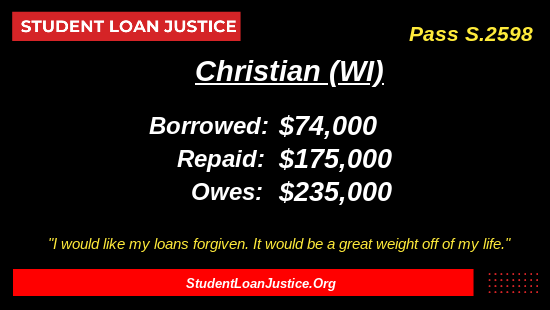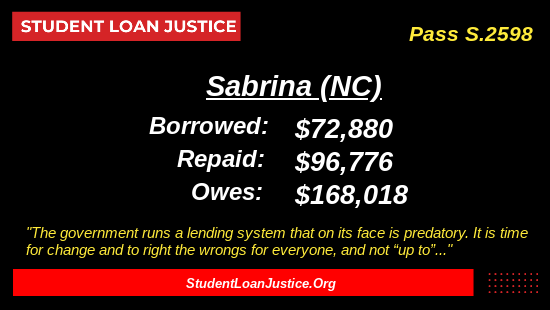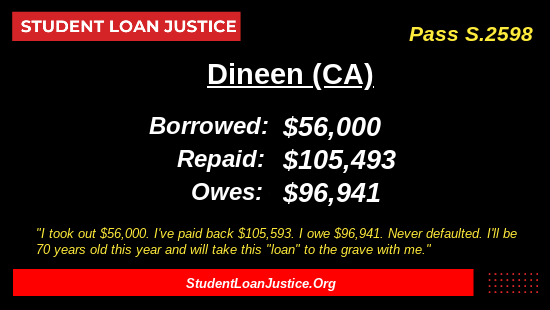The Vast Majority of the Federal Student Loan Portfolio is Profit.
The loans can be cancelled entirely at little- or no- cost to the taxpayers.

Updated: December 21st, 2023.
For decades, student loan interests- both inside and outside of government- have been claiming that the federal student loan program has been a cost to taxpayers. More recently, they are claiming that cancelling federal student loans would be a cost to the taxpayers. Both of these claims are provably false, and must be debunked.
The General Accounting Office (GAO) recently published a report claiming that the federal Direct Student Loan program was, on balance, a cost to the federal government, rather than an income source as was previously reported. In 2013, for example, the Congressional Budget Office said that in 2012, the government had profited $50 billion on the program, and that this would increase as the portfolio increased (and it has). The GAO’s most recent claim, however, is that the federal government made very little in 2012 ($600 million), and this profit turned into annual losses in subsequent years- to over $20 billion/year by 2017.
So why such a massive difference in profit/loss estimates?
Two of the three areas that the GAO study said were responsible for this cost were Income Driven Repayment (IDR) programs (where borrowers pay based upon their income for an extended period, and their loan balances are cancelled at the end of the term), and also the cost of defaulted loans.
Both of these areas, however, are not costs to the government. In fact, they are profit centers.
First: The GAO assumes that a significant percentage of the borrowers in the IDR programs will ultimately receive loan cancellation by completing the IDR program or through Public Service Loan Forgiveness (they rely on the Department of Education’s claim, for example, that 58% of borrowers entering IDR’s in 2023 will successfully complete these plans and receive loan cancellation). But history shows that the overwhelming majority (99%) of borrowers who try for these IDR programs are being disqualified out of the programs, and receive no loan cancellation.
For example: of millions of people who enrolled in the Income Contingent Repayment Program (ICR) since 1995, only 32 people had made it through as of 2021.
Similarly, it was reported in 2015 that 57% of the those enrolled in IDR programs had been disqualified in one year alone for failure to “verify their income”, an annual, onerous exercise required of the borrowers- and one of many ways the Department has to disqualify people out of the programs. Given that around 30% of these income verification forms are rejected per year, a simple calculation shows that the probability of making it through 20 consecutive years shrinks to 0.08%- a vanishingly small percentage.
For the Public Service Loan Forgiveness Program (PSLF), the disqualification rate was 99% as of 2018. It remains to be seen what results an “overhauled” version of this plan will yield, but anecdotally, stories from borrowers who are still being denied abound. It would be surprising, frankly, if even 10% of those who thought they would get forgiveness through this program actually do.
While it is true that the Department of Education cancelled a non-negligible number of federal student loans in the first 3 years of the Biden Administration($131 Billion), this pales in comparison with the growth of the federal loan portfolio during a typical 3-year span, where the portfolio grows by over $600 Billion, so that this level of cancellations could continue ad-infinitum, and the federal student loan balance would still grow by $1.6 Trillion over ten years, which doesn’t even include capitalized interest, which would add, likely, hundreds of billions more to the balance owing.

Ironically: Most people enrolled in IDR’s have increasing loan balances throughout the term of their repayment. When they are disqualified out of these programs, they are usually left owing a far larger balance than had they never tried in the first place. At least on the books- the Department of Education should be booking a profit rather than incurring a cost due to these non-functioning IDR plans.
The Department of Education clearly has no desires or intentions of cancelling any loans if it isn’t forced to. It guards it’s profit-generating cash-cow fiercely. no matter how high the cost (and harm) to the citizenry.
Second: Decades of White House Budget data show that the government actually makes a profit- not a loss- on defaulted student loans. This was true in 2010, when the White House reported a recovery rate on defaulted FFELP (federally guaranteed) loans of 122% (all other loans the government made or insured that year had an average recovery rate of about 34%). It is still true- in fact more true- today.
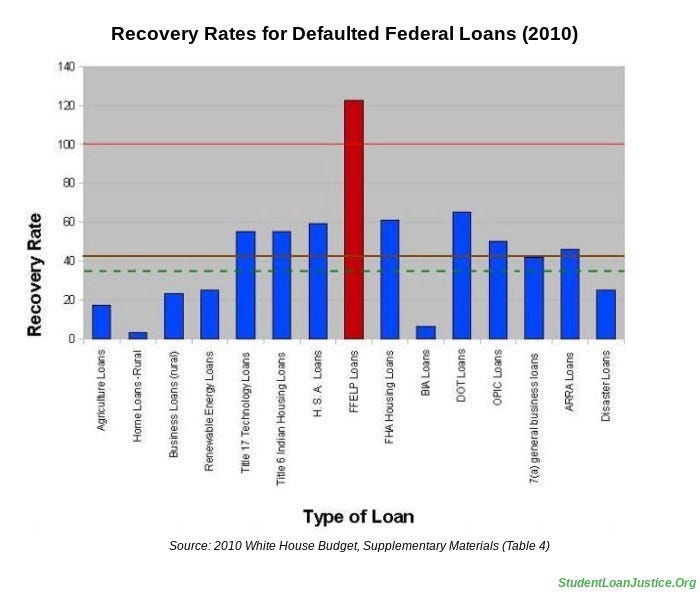
More recent White House Budget Data (2022), shows that this trend has continued for the Direct Loan Program, with an average recovery rate of over 100%. Similar to the 2010 data, student loans were the only type of loan that could be found in the federal portfolio for which the recovery rate exceeded 100%

A key point: While the recovery rate for Direct Loans in 2022 was lower than for FFELP (federally guaranteed) loans in 2010, Direct Loan recoveries are inherently far more profitable than FFELP loans. For defaulted FFELP loans, the government, makes no interest on the loan prior to default, and pays a claim amounting to the entire balance of the loan (including interest)at the time of default, which includes both unpaid principal and interest.
For Direct, Loans, however, the government only paid the original loan amount, which is typically far, far lower than the value of the loan at the time of default. The recovery rate for both, however is calculated by comparing the amount recovered to the balance of the loan at the time of default.
So while the recovery rate for Direct loans in 2022 are lower than that of FFELP loans in 2010, the profitability of these recoveries is actually much greater.
In a lending environment where defaults are actually profitable, and almost no loans are being cancelled, it is literally impossible to lose money on the loans. In fact, the program can only be making money from the program…and a lot of it. All of this profit for loans that President Lyndon Johnson said would be made “free of interest” when he signed the Higher Education Act into law in 1965.
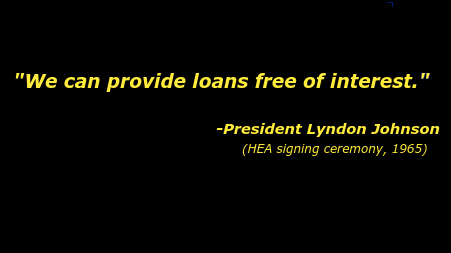
Those claiming that cancelling loans would be a cost to the taxpayers, like Marc Goldwein from the Committee for a Responsible Federal Budget, have acknowledged that in recent years, the government has been collecting around $85 billion/year on the federal student loan program. The government has been lending out roughly $95 billion during these same years. Given these cash flows, it is clear that the actual unrecouped monies the government has seen has been very small, perhaps only $100 billion during the past decade, and perhaps nothing when considering profits realized in years prior.
The federally owned portfolio could be entirely erased, and the government would only be out around $100 Billion, or perhaps even nothing. Certainly not the trillions that are being reported currently in the mainstream media (at the urging of “experts” like Goldwein, and others), and for Biden’s much smaller and unimpressive cancellation announcement.
The GAO is (or should be) well aware of the disqualification rates for IDRs and the profitability of Direct Loan defaults. Beltway “experts” like Goldwein and many others know full well that the large majority of the portfolio is profit. That they choose to ignore these facts in their analysis constitutes gross neglect at best. At worst, their blatant disregard for these key facts constitutes professional malpractice and willful deception.
Congress should immediately investigate the principals involved in producing this flawed analysis (including those in Congress who ordered the study), and call for a revision of the study, to reflect the profitability of defaults, and the true disqualification rate for IDR’s. This will clearly show that the government has, in fact, been making a huge profit on these loans, rather than incurring losses.
Author Note:
The unprecedented, and unwarranted removal of both bankruptcy rights, and statutes of limitations lie at the core of the student loan problem. In the absence of these protections, the lending side (up to and including the Department of Education) can- and does use this power to abuse the borrowers, extract vast sums of wealth from them, and ruin their lives (see the examples below). The real, human cost of this predatory lending system has been massive. The cost that is poised to be exacted on the citizenry is incalculable.
At a minimum, constitutional bankruptcy rights must be returned to these loans. S.2598 will achieve that on a limited basis, and also will hold colleges somewhat responsible for discharges. This bill must be passed at once. Frankly, however the entire lending system is now catastrophically failed by most rational metrics. Widespread- if not total- loan cancellation will surely be needed going forward.
Please sign this petition if you agree.
